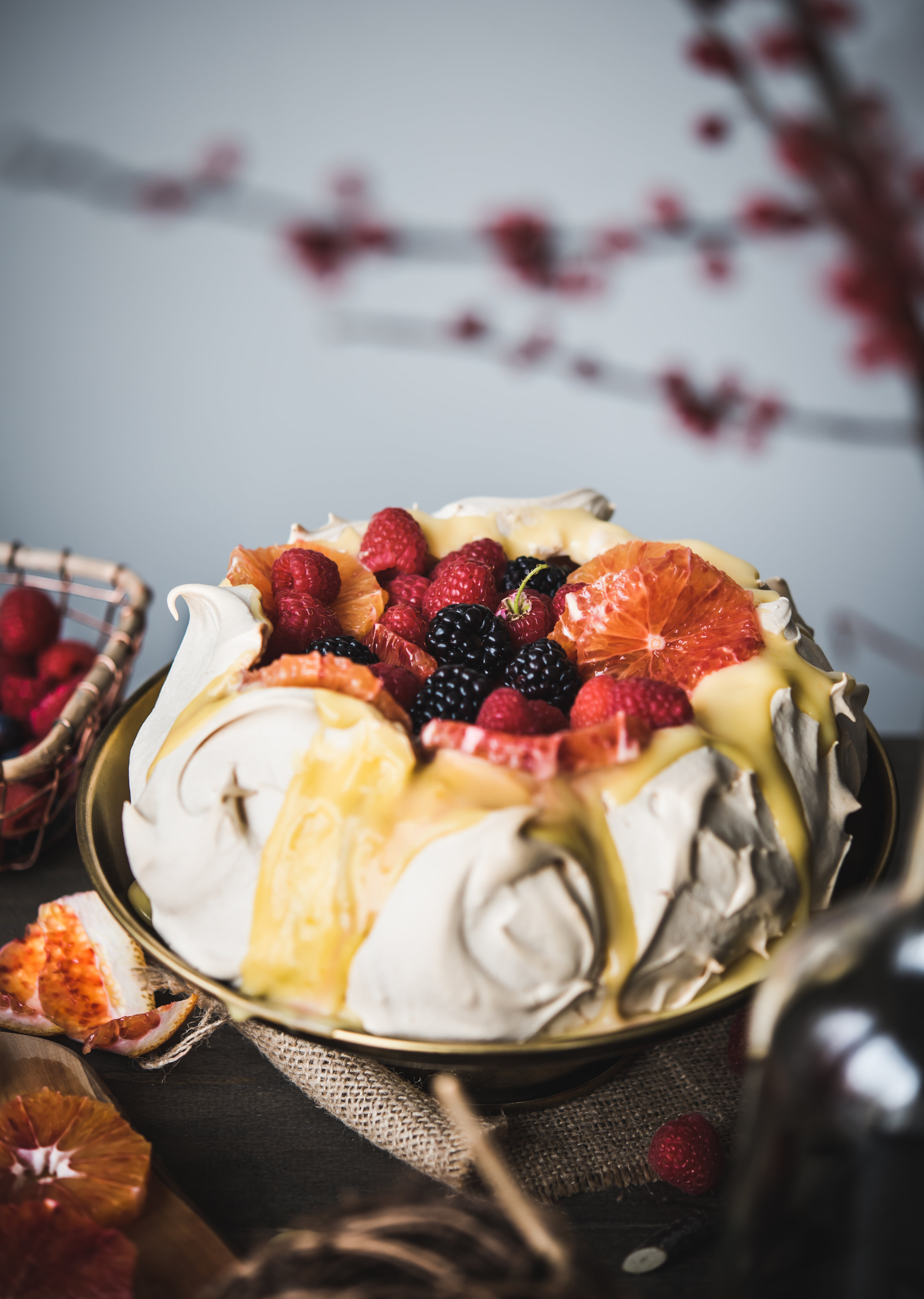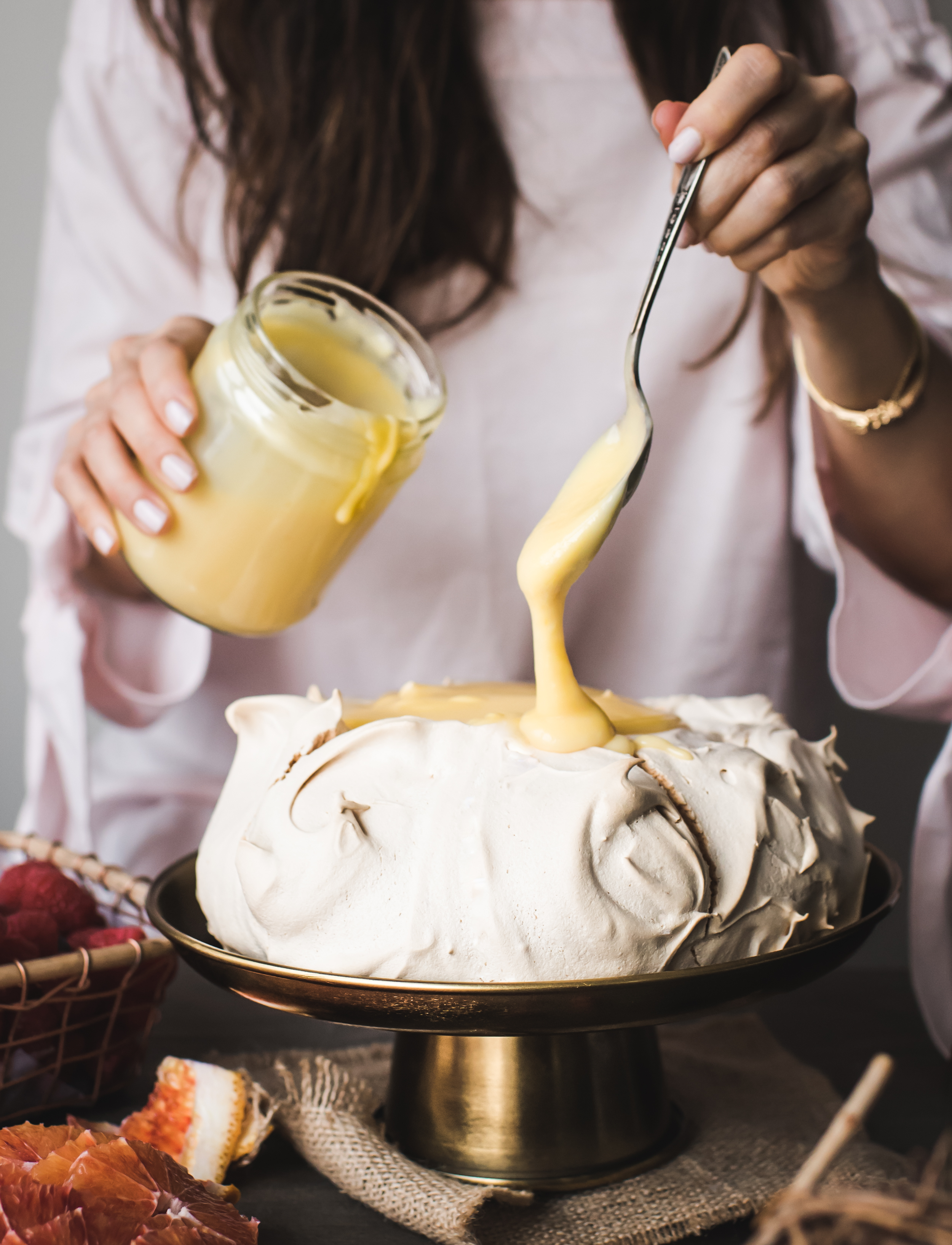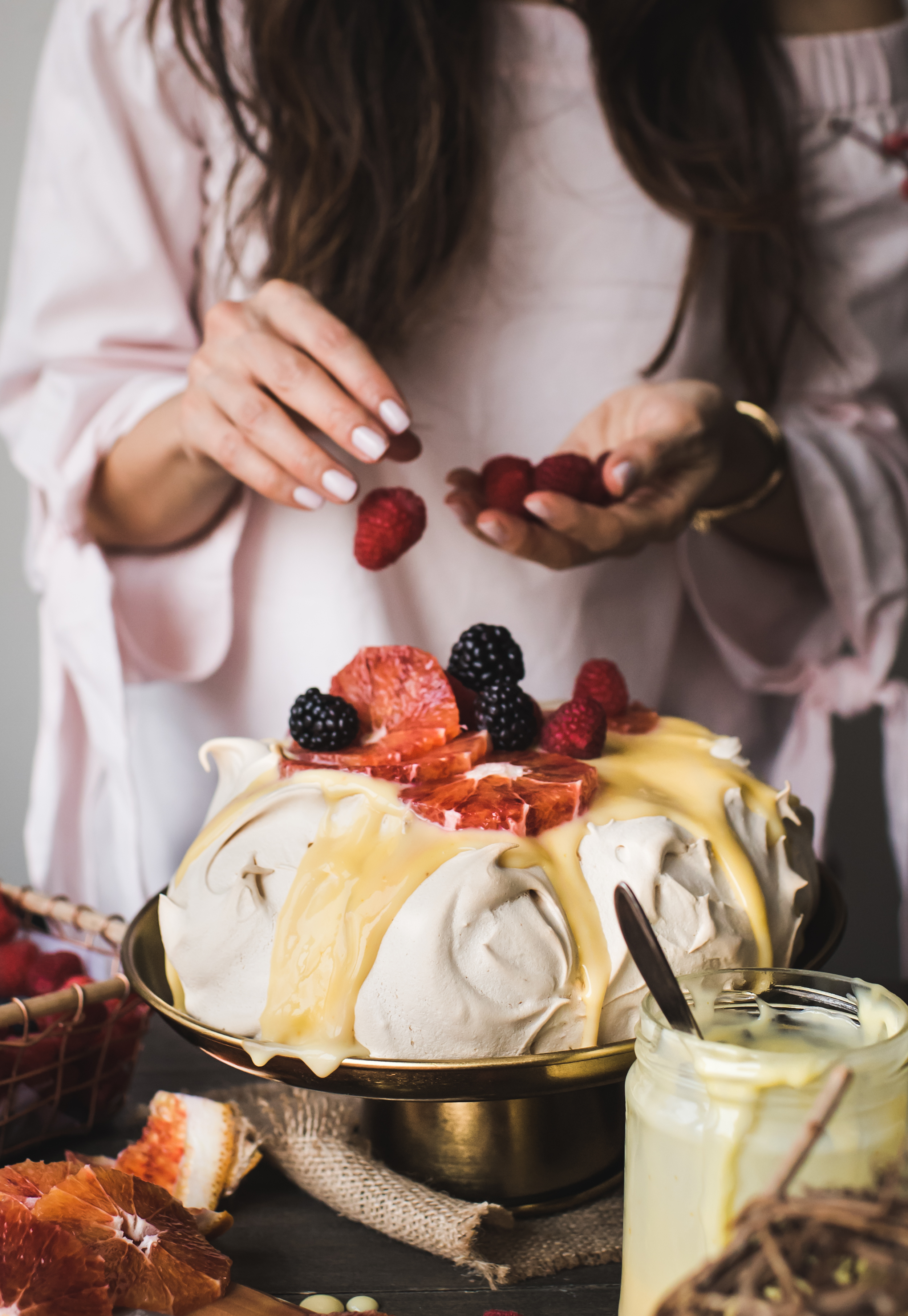Winter Pavlova with Meyer Lemon Curd { gluten-free, dairy-free }
Remember my last recipe, those Sticky Rice Cakes with the salt-cured yolks and peanut butter inside? It left me with 8 orphaned egg whites so had no choice but to at least use up 4 of them in this Pavlova. Twist my rubber arm...
Pavlovas don't normally come to mind in the winter since they are generally regarded as a summer dessert. I always questioned the sense in that though? High humidity is the serial murderer of pavlovas. Sure there are other factors that could undermine your pavlova, such as whites contaminated with yolks or grease / water in the mixing bowl, but I assert that weather is public enemy number one since it is not a factor you get to control.
When you're looking for that perfect crispy exterior that yields into a marshmallow-y center, but the day you're serving it to a large group of people turns out to be a hot and rainy day in August with 35% humidex, a Plan B would have been wise. That was my first time baking meringue, almost ten years ago. I made four dozen mini meringue cookies topped with whipped cream and strawberries that were perfect and beautiful. I ever so carefully transferred them to my brother-in-law's store opening but midway through the party, all of them turned into tragic little puddles of mush.
I learned a lesson that evening I won't easily forget - humiliation tends to leave a mark, doesn't it? So when the thought of making a pavlova popped into my head last week, I finally found the ONE SILVER LINING of this dreadfully frigid winter in Toronto: no risk of humidity!
Apart from the dry weather being in my favor, I also thought how perfect to feature my most beloved winter citruses in this stunning dessert - Meyer lemons and blood oranges. If these varieties are not accessible for you or not currently in season, regular lemons (for the curd) and navel oranges (for the top) make excellent substitutions.
When you read the recipe, you'll see that the lemon curd is slightly healthier than traditional curds since it uses honey as the sweetener and ghee as the fat (or else I suggest grass-fed organic butter). I love how the sweet-tartness of citrus balances the sweet meringue! Isn't it all just so lovely to look at? It's even lovelier to taste.
You may also like my PEACH + PASSIONFRUIT PAVLOVA!
Tips and FAQs
CLEAN MIXING BOWL AND TOOLS:
Make sure your mixing bowl, whisk, spatula, hands, etc are all clean and free of any oil or water, which can interfere with the egg whites whisking up properly.
SEPARATE EGGS WHILE COLD BUT WHIP THEM AT ROOM TEMPERATURE:
Cold eggs separate a little bit more easily. For meringue to whip up properly, there must be no traces of egg yolk remaining in the whites. Once whites are separated, let them come to room temperature because they whip up better.
USE A KITCHEN SCALE TO WEIGH EGG WHITES AND SUGAR:
Egg whites to sugar ratio is important for structurally sound meringue. I provide weight measurements in the recipe because it is the most accurate. A “large” egg can vary in size. I’m not saying you can’t make meringue without a scale, but it is a great way to ensure your white-to-sugar ratio is right.
USE SUPERFINE SUGAR:
Also called “caster sugar”, superfine sugar is simply sugar that has been processed to a finer ground than regular granulated sugar. The sugar helps with structure of the meringue so you want to ensure it is dissolved fully in the meringue for a glossy, stiff result. Rub a bit of meringue between your fingers to ensure it is smooth, glossy and free of any grit from undissolved sugar.
WHIP TO STIFF PEAKS:
Take the time to whip the meringue to a stiff peak. This means, when your whisk is lifted off the mixture, the meringue stands up on its own. A fun way to test is to flip mixing bowl upside down to confirm the meringue does not budge or slide out of the bowl.
FORMING THE MERINGUE FOR STABILITY:
Pavlovas come in various sizes and shapes. Shaping the meringue is probably the most fun and artistic part of the process. If you’re new to it and worried about cracking or collapsing, or perhaps you need your pavlova to hold it’s shape for more than a few hours, one option for more stability is to divide and bake the mixture as two flattened discs for a two-layered pavlova (as pictured in this blog post). Note that dividing into two thinner meringues discs means they bake up less marshmallowy in the center. But this becomes less and less noticeable as the meringue softens under the toppings anyway. Tip: if baking two meringues, confirm your two baking sheets can fit side-by-side in your oven. If you go with a single meringue layer, you can also shape it thicker and shorter, with a slight crater on top to fill with cream and fruit after baking.
BAKE LOW AND SLOW IN THE OVEN:
To minimize cracking during baking, the meringue is baked at a low temperature. Note that I preheat the oven to 275f and TURN IT DOWN TO 250f before placing meringue in the oven for baking. Alternatively, you may set the oven to 275f and keep it there. My oven tends to run hot so I prefer to turn it down. Either way, the point is to avoid too-rapid expansion of the meringue which can cause cracking.
COOL DOWN SLOWLY:
To prevent cracking, the baked meringue should also cool down to room temperature gradually. For this reason, I always bake my meringues the night before, turn off the oven and let them cool slowly overnight. If you don’t have the time, allow a minimum of 2 hours (but ideally at least 6 hours) to cool in the oven before taking it out of the oven to cool the rest of the way on a wire rack. In the event the meringue does crack or collapse, it will still taste amazing! You can also turn it into a Eton’s mess to hide the broken meringue.
TOP WITH CREAM AND FRUIT JUST BEFORE SERVING:
Even in the fridge, baked meringue will absorb moisture from the cream and fruit, becoming softer over time. To keep it crisp, leave your prepared whipped cream and fruit separate until just before serving. A second reason to assemble just before serving is the weight of cream and fruit may also cause the meringue to collapse after awhile.
Avoid baking meringues on SUPER HUMID / WET DAYS:
Sorry to say this, but abort and find a Plan B if it is a super humid day 🥲 Humidity is the enemy of baked meringues! Baked meringue absorbs moisture from the toppings. They also absorb moisture from the air. On humid days, baked meringues don’t stand a chance against getting soggy. If you must still make it, make sure the environment is well air-conditioned. You can also freeze naked baked meringues to keep dry, if making ahead. They are delicate so make sure to use a hard container to protect them from getting crushed or banged around by other things in the freezer.
Recipe Notes Winter Pavlova with Meyer Lemon Curd:
1. Meringue: It's preferable to bake the meringue in advance and allow it to cool down gradually while still inside the oven overnight or as long as you can. The slow cooling down helps prevent collapsing and cracking. But don’t worry too much even if there is cracking or collapsing in the middle - this does happen and won’t affect the taste of the pavlova whatsoever.
2. Castor sugar: Aka superfine sugar can be store-bought or made by whizzing granulated sugar in the food processor until very fine. It is preferably to use superfine sugar in the meringue as it dissolves more quickly than granulated sugar, ensuring a smooth meringue.
3. Corn Starch: The cornstarch creates a chewier, less brittle texture in the baked meringue. I used to omit this out of practicality because I rarely had cornstarch in the house during our Paleo grain-free days. Now I buy organic corn starch and use it in this recipe.
Winter Pavlova with Meyer Lemon Curd
Gluten-free, dairy-free. Recipe makes one 8” pavlova which serves 8.
INGREDIENTS
For the Meyer Lemon Curd (makes ~ ½ cup):
1 large egg
1 large egg yolk
3 tbsp honey
Zest of 1 Meyer lemon (or regular lemon)
¼ C (60ml) fresh lemon juice, from 2-3 Meyer lemons (or regular lemons)
Pinch sea salt
3 tbsp ghee (or grass-fed organic butter if dairy is not an issue)
For the meringue:
4 large fridge-cold egg whites (preferably weighed on a scale to 5 oz of whites)
1 C (220g) superfine aka caster sugar
1 tsp white vinegar OR pinch cream of tartar
1 tbsp cornstarch
For topping the pavlova:
½ C Meyer lemon curd from above
1-2 blood oranges, peeled and cut into ¼" thick slices (can sub other orange varieties)
Assorted berries, washed and blotted well on paper towels
METHOD
Prepare mixing bowl and whisk: Take out a large bowl or stand mixer bowl and whisk attachment. Make sure everything is completely clean and free of any grease or water.
Separate egg whites: While eggs are still cold (for easier separation), separate whites from yolks. Be careful not to get a single drop of yolk in the whites. Egg whites contaminated with yolk will not whip up properly and is better used for breakfast scramble or fried rice. If you need to be extra careful, separate one egg at a time into a small bowl first and only place the white in your stand mixer bowl once you're successful. If time permits, allow egg whites to come to room temperature – this helps them whip up fluffier.
Meanwhile, make the lemon curd: Heat and whisk all the curd ingredients in a small pot over low heat. Once the ghee (or butter) has completely melted, increase the heat to medium-low and cook 5-7 minutes or until tiny bubbles surface, stirring frequently. Strain over a sieve and set aside. The curd will thicken further as it cools. If making in advance, store refrigerated in an air-tight container until ready to use.
Preheat oven and prepare baking sheet: Preheat oven to 350f. (**note** you will turn this down to 250f later, before placing meringue in the oven). Place oven rack to one notch below the middle. Draw an 8" circle on each parchment paper and flip drawn-side down on the baking sheet.
Whip meringue: Whisk egg whites on medium-high (level 6 on stand mixer) until soft peaks which means the peaks are just starting to hold and doesn't stand on their own (this provides a great visual guide for soft, medium, firm peaks). Add sugar by tablespoons as you continue whisking. After all sugar is in, increase speed to high (level 8 on stand mixer) and continue beating 2-3 minutes more until thick and glossy, and sugar is completely dissolved. Confirm by rubbing a bit of meringue between your fingers – there should be no grit. Stir in vinegar or cream of tartar and corn starch. Mix well.
Form and bake the meringue: Dab a bit of meringue on four corners of the underside of the prepared parchment to keep it from lifting up when you form the pavlova. Scoop about half the meringue onto the center of the drawn circle and begin shaping it to the desired size with a spatula. Scoop out the remaining meringue on top and shape into a slightly curved dome. This is the fun part - use your spatula to make swooshes or the design of your choice on the sides. Place baking sheet gently in oven and close the oven door preferably without banging anything. **TURN THE OVEN DOWN TO 250f**. Bake without peeping for 1.5 hours. Turn oven off. Open oven door a bit (wedge a wooden spoon handle to keep it ajar if needed) and allow the pavlova to gradually cool fully. You can leave it inside the oven like that as long as overnight. If you are in a hurry, cool it down out of the oven on a wire rack but it may crack more, if that bothers you.
Assemble: Once ready to serve, pour lemon curd over the top of the pavlova. Add prepared fresh fruits and serve immediately. Avoid putting toppings on too early (I'd say 20-30 minutes max) or else the weight might cause the pavlova to collapse. This does happen from time to time, and it did when I took too long photographing it for the blog post. But can you blame me? So pretty!
Enjoy!
If you like this recipe, pin it to Pinterest! You can also leave me a comment below to let me know what you think of this post - I would love that. :)






